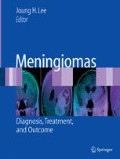In this chapter the functional anatomy of human meninges is described, with particular attention paid to the pathological aspects. The meninges, the intricate and complex coverings of the brain and spinal cord, are basically comprised of three distinct yet closely associated layers: dura mater, arachnoid, and pia mater. Dura mater is thick, while the arachnoid is thin, and the subarachnoid space is of varying thickness. Dura mater is comprised of periosteal dura, meningeal dura, and dural border layer. The arachnoid is comprised of an arachnoid barrier layer and arachnoid trabeculae. For the thorough understanding of the meninges and related structures, not only gross but also light and electron microscopic observations and molecular analyses are indispensable. However, from postmortem analyses it is not possible to determine in situ features of the meninges in the living individual. Meninges are essentially composed of a series of fibroblasts and/or arachnoid cells, as well as varying amounts of extracellular materials, fibers, and fluid-filled cisterns. Usually considered as a simple protective covering, the meninges are closely related to both physiology and pathology of the central nervous system. Dura mater is a rigid but simple covering of the brain as an internal covering of calvaria. Dura mater forms venous sinuses that drain not only blood but also the cerebro-spinal fluid (CSF).
Access this chapter
Tax calculation will be finalised at checkout
Purchases are for personal use only
Preview
Unable to display preview. Download preview PDF.
References
Haines DE, Harkey HL, al-Mefty O. The “subdural” space: a new look at an outdated concept. Neurosurg 1993; 32:111–20. Review.
Schachenmayr W, Friede RL. The origin of subdural neomem-branes. I. Fine structure of the dura-arachnoid interface in man. Am J Pathol 1978; 92:53–68.
Yamashima T, Friede RL. Light and electron microscopic studies on the subdural space, the subarachnoid space and the arachnoid membrane. Neurol Med Chir (Tokyo) 1984; 24:737–46. (Japanese)
Haines DE, Frederickson RG. The meninges. In Meningiomas (Al-Mefty, ed.). Raven Press, New York, 1991.
Hasegawa M, Yamashima T, Kida S, Yamashita J. Membranous ultrastructure of human arachnoid cells. J Neuropathol Exp Neu-rol 1997; 56:1217–27.
Reina MA, Lopez Garcia A, de Andres JA. Anatomical description of a natural perforation present in the human lumbar pia mater. Rev Esp Anestesiol Reanim 1998; 45:4–7. (Spanish)
Alcolado R, Weller RO, Parrish EP, et al. The cranial arachnoid and pia mater in man: anatomical and ultrastructural observations. Neuropathol Appl Neurobiol 1988; 14:1–17.
Hutchings M, Weller RO. Anatomical relationships of the pai mater to cerebral vessels in man. J Neurosurg 1986; 65:316–25.
Yamashima T, Yamamoto S. The origin of inner membranes in chronic subdural hematomas. Acta Neuropathol (Berl) 1985; 67:219–25.
Yamashima T. Ultrastructural study of the final cerebrospinal fluid pathway in human arachnoid villi. Brain Res 1986; 384:68–76.
Yamashima T, Sakuda K, Tohma Y, et al. Prostaglandin D synthase (beta-trace) in human arachnoid and meningioma cells: roles as a cell marker or in cerebrospinal fluid absorption, tumorigenesis, and calcification process. J Neurosci 1997; 17:2376–82.
Kivisakk P, Mahad DJ, Callahan MK, et al. Human cerebrospi-nal fluid central memory CD4+ T cells: evidence for trafficking through choroid plexus and meninges via P-selectin. Proc Natl Acad Sci USA 2003; 100:8389–94.
Brunori A, Vagnozzi R, Giuffre R. Antonio Pacchioni (1665–1726): early studies of the dura mater. J Neurosurg 1993; 78:515–8
Tohma Y, Yamashima T, Yamashita J. Immunohistochemical localization of cell adhesion molecule epithelial cadherin in human arachnoid villi and meningiomas. Cancer Res 1992; 52:1981–7.
Yamashima T, Tohma Y, Yamashita J. Expression of cell adhesion molecule E-cadherin in human arachnoid villi. J Neurosurg 1992; 77:749–56.
Ikushima I, Korogi Y, Makita O, et al. MRI of arachnoid granulations within the dural sinuses using a FLAIR pulse sequence. Br J Radiol 1999; 72:1046–51.
Massicotte EM, Del Bigio MR. Human arachnoid villi response to subarachnoid hemorrhage: possible relationship to chronic hydrocephalus. J Neurosurg 1999; 91:80–4.
Kaneko T, Yamashima T, Tohma Y, et al. Calpain-dependent pro-teolysis of merlin occurs by oxidative stress in meningiomas: a novel hypothesis of tumorigenesis. Cancer 2001; 92:2662–72.
Clausen J. Proteins in normal cerebrospinal fluid not found in serum. Proc Soc Exp Biol Med 1961; 107:170–2.
Hoffmann A, Conradt HS, Gross G, et al. Purification and chemical characterization of β-trace protein from human cere-brospinal fluid: its identification as prostaglandin D synthase. J Neurochem 1993; 61:451–6.
Pervaiz S, Brew K. Homology and structure-function correlations between 1-acid glycoprotein and serum retinol-binding protein and its relatives. FASEB J 1987; 1:209–214.
Zahn M, Mäder M, Schmidt B, et al. Purification and N-terminal sequence of β-trace, a protein abundant in human cerebrospinal fluid. Neurosci Lett 1993; 154:93–5.
Nagata A, Suzuki Y, Igarashi M, et al. Human brain prostaglan-din D synthase has been evolutionarily differentiated from lipophilic-ligand carrier proteins. Proc Natl Acad Sci USA 1991; 88:4020–4.
Urade Y. Dual function of β-trace. Prostaglandins 1996; 51:286.
Ujihara M, Urade Y, Eguchi N, et al. Prostaglandin D2 formation and characterization of its synthetases in various tissues of adult rats. Arch Biochem Biophys 1988; 260:521–31.
Hara A, Yamada H, Sakai N, et al. Immunohistochemical expression of glutathione S-transferase placental type (GST-), a detoxifying enzyme, in normal arachnoid villi and meningiomas. Virchows Arch [A] 1990; 6:493–6.
Yamashima T, Yamashita J. Histological, ultrastructural, and chromatographical discrimination of phospholipids in meningio-mas. Acta Neuropathol 1990; 80:255–9.
Author information
Authors and Affiliations
Editor information
Editors and Affiliations
Rights and permissions
Copyright information
© 2009 Springer-Verlag London Limited
About this chapter
Cite this chapter
Yamashima, T. (2009). Human Meninges: Anatomy and Its Role in Meningioma Pathogenesis. In: Lee, J.H. (eds) Meningiomas. Springer, London. https://doi.org/10.1007/978-1-84628-784-8_3
Download citation
DOI: https://doi.org/10.1007/978-1-84628-784-8_3
Publisher Name: Springer, London
Print ISBN: 978-1-84882-910-7
Online ISBN: 978-1-84628-784-8
eBook Packages: MedicineMedicine (R0)

